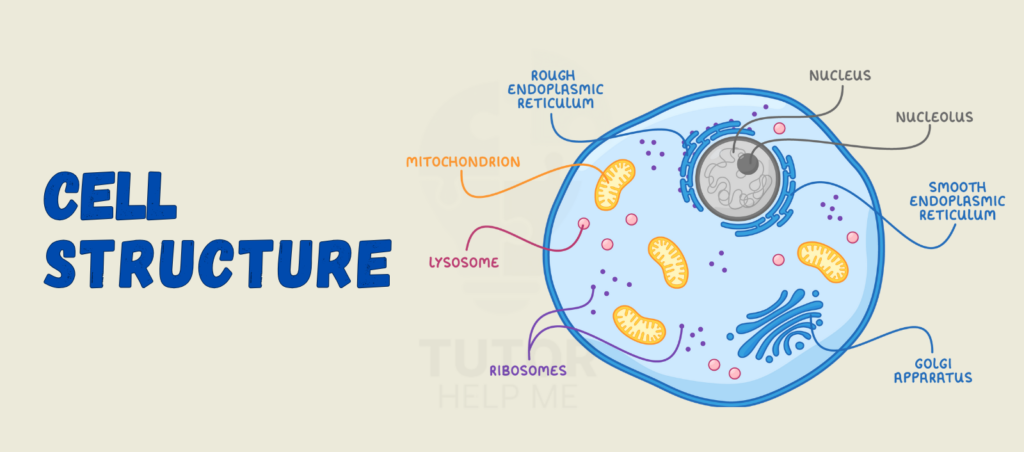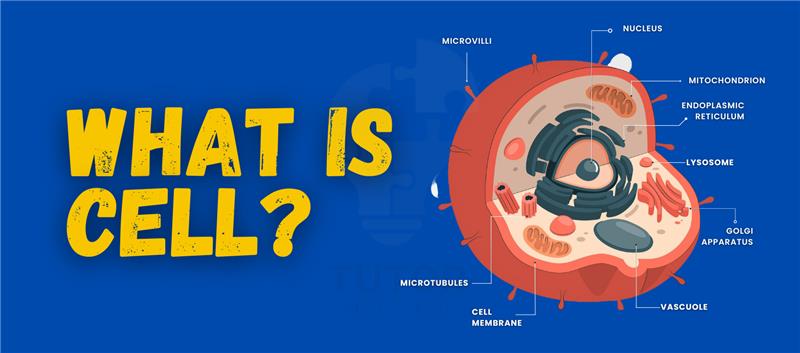A cell is the basic building block of all living things. It is the smallest part of life and does important jobs to keep organisms alive. There are two main types of cells: Prokaryotic and Eukaryotic cells.
Each type has its own structure and specific jobs. Cells help living things grow, heal, and stay healthy. They have parts, like the nucleus, that control what they do.
In this blog, we will talk about the types of cells, what they look like, what they do, and their main features. Let’s explore these tiny but amazing parts of life!
Cells Definition
Cells are the building blocks of all living things. They are the smallest parts of life. Cells do important jobs that keep plants, animals, and people alive.
What is Cell?
A cell is the smallest unit of life and the building block of all living things. It performs vital tasks like growing, healing, and keeping the body healthy. There are two main types of cells: plant cells and animal cells.
Each type has its own structure and job. Cells contain special parts, like the nucleus, that control their activities. They work together to support life in plants, animals, and humans.
Every living thing is made up of cells, from tiny bacteria to large animals. Cells are tiny but play a huge role in making life possible.
Function of cells
- Energy Production: Cells turn food into energy through processes like cellular respiration.
- Growth: Cells divide to help an organism grow and develop.
- Reproduction: Cells reproduce to make new cells for the body.
- Protection: Cells protect the body by acting as barriers, like the skin.
- Transport: Cells help move materials (like nutrients) inside the body.
- Communication: Cells send signals to other cells to work together.
- Waste Removal: Cells remove waste to keep the body healthy.
- Defense: Cells protect against harmful invaders like bacteria and viruses.
- Repair: Cells help heal and repair damaged tissues.
- Specialization: Some cells do specific jobs, like muscle or nerve cells.
Structure of cell
- Cell Membrane: The outer layer of the cell. It decides what can go in or out, like a gatekeeper.
- Nucleus: The brain of the cell. It holds DNA and tells the cell what to do.
- Cytoplasm: A jelly-like fluid inside the cell. It helps hold and protect the parts of the cell.
- Mitochondria: The cell’s energy makers. They turn food into energy.
- Endoplasmic Reticulum (ER): A network inside the cell that moves things around. The rough ER makes proteins, and the smooth ER makes fats.
- Ribosomes: Tiny parts of the cell that make proteins, which help the cell work.
- Golgi Apparatus: The packaging center of the cell. It gets proteins and fats ready and sends them to where they are needed.
- Lysosomes: Small parts of the cell that break down waste and old parts.
- Vacuoles: Storage areas in the cell. They hold water, food, and waste.
- Cytoskeleton: A structure that helps the cell stay in shape and move.

Types of Cells
There are two types of cells:
- Prokaryotic Cells
- Eukaryotic Cells
Prokaryotic Cells
Prokaryotic cells are simple cells without a nucleus. Their genetic material floats inside the cell. These cells are small and found in organisms like bacteria. Prokaryotic cells perform basic life functions to help these tiny organisms survive.
Characteristics of Prokaryotic Cells
- No Nucleus: Genetic material floats freely in the cytoplasm.
- Simple Structure: Smaller and less complex than eukaryotic cells.
- Cell Wall: Provides shape and protection.
- Single Chromosome: Contains circular DNA.
- No Organelles: Lacks membrane-bound organelles like a nucleus or mitochondria.
- Ribosomes: Present for protein synthesis but smaller in size.
- Reproduction: Divides through binary fission.
- Unicellular: Mostly found in single-celled organisms like bacteria.
- Plasma Membrane: Controls what enters and exits the cell.
- Flagella: Some have tail-like structures for movement.
Prokaryotic Cell Structure
- Cell Wall: Provides shape and protection.
- Plasma Membrane: Regulates entry and exit of substances.
- Cytoplasm: Jelly-like substance where cell processes occur.
- Nucleoid: Region containing circular DNA.
- Ribosomes: Small structures for protein synthesis.
- Flagella: Tail-like structure for movement (in some cells).
- Pili: Hair-like structures for attachment and gene transfer.
- Capsule: Outer layer providing extra protection (in some cells).
- Plasmids: Small DNA molecules with more genetic information.
- Mesosomes: Folded plasma membrane involved in cell processes.
Eukaryotic Cells
Eukaryotic cells have a nucleus with a membrane around it. They also have organelles like mitochondria and, in plants, chloroplasts. These cells are in plants, animals, fungi, and protists. Each part helps the cell carry out life processes.
Characteristics of Eukaryotic Cells
- Nucleus: Contains DNA, controlling cell activities.
- Membrane-bound Organelles: Includes mitochondria, chloroplasts (in plants), and others.
- Larger Size: Bigger than prokaryotic cells.
- Complex Structure: More organized with specialized parts.
- Cell Membrane: Protects the cell and controls what enters or leaves.
- Cytoplasm: Gel-like substance where organelles float and processes happen.
- Multicellular or Unicellular: Can be part of a complex organism or a single organism.
- Cell Division: Reproduces through processes like mitosis and meiosis.
- Energy Production: Mitochondria generate energy.
Eukaryotic Cell Structure
- Nucleus: Contains genetic material (DNA) and controls cell activities.
- Cell Membrane: Protects the cell and regulates what enters and exits.
- Cytoplasm: Jelly-like substance where cell activities happen.
- Mitochondria: Produce energy for the cell.
- Endoplasmic Reticulum (ER): Transports proteins and other materials (smooth and rough types).
- Golgi Apparatus: Modifies and packages proteins for transport.
- Lysosomes: Break down waste materials and cellular debris.
- Vacuoles: Store nutrients, waste, and help with cell structure.
- Chloroplasts (in plants): Carry out photosynthesis to make food for the cell.
- Cytoskeleton: Provides structure and support to the cell.
Difference between Prokaryotic cell and Eukaryotic cell
| Aspect | Prokaryotic Cell | Eukaryotic Cell |
|---|---|---|
| Definition | Cells without a true nucleus or membrane-bound organelles. | Cells with a true nucleus and membrane-bound organelles. |
| Size | Small, typically 1-10 µm. | Larger, typically 10-100 µm. |
| Nucleus | No true nucleus; DNA is located in a nucleoid region without a membrane. | True nucleus present, enclosed by a nuclear membrane. |
| DNA Structure | Circular DNA, not associated with histone proteins. | Linear DNA, associated with histone proteins, organised into chromosomes. |
| Cell Division | Divides by binary fission, a simpler process. | Divides by mitosis (for growth) and meiosis (for reproduction). |
| Organelles | Lacks membrane-bound organelles such as mitochondria, ER, or Golgi apparatus. | Contains membrane-bound organelles like mitochondria, endoplasmic reticulum, Golgi apparatus, lysosomes, etc. |
| Cytoskeleton | Absent or minimally developed. | Well-developed cytoskeleton made of microtubules, microfilaments, and intermediate filaments. |
| Ribosome Size | Smaller ribosomes (70S). | Larger ribosomes (80S) in the cytoplasm, though 70S ribosomes exist in mitochondria and chloroplasts. |
| Cell Wall | Present in most (e.g., bacteria) and made of peptidoglycan in bacteria. | Present in plants (cellulose), fungi (chitin), and some protists; absent in animal cells. |
| Plasma Membrane | Simple structure without sterols. | Complex structure with sterols (e.g., cholesterol in animal cells). |
| Flagella | Simple, made of a single protein (flagellin). | Complex, made of microtubules in a 9+2 arrangement (e.g., in animal cells). |
| Respiration and Energy | Cellular respiration occurs on the plasma membrane or mesosomes (folds of the membrane). | Cellular respiration occurs in mitochondria. |
| Reproduction | Asexual reproduction only, primarily through binary fission. | Both asexual (mitosis) and sexual (meiosis) reproduction. |
| Examples | Bacteria and Archaea. | Animals, plants, fungi, protists, and algae. |
Why Choose TutorHelpMe Biology Tutors?
- Expert Biology Tutors: Teachers who know a lot about biology.
- Personalised Help: Lessons made just for you.
- Flexible Timing: Learn at times that work best for you.
- Affordable: Good learning at low prices.
- Fun Lessons: Interesting and easy-to-follow teaching.
- Covers All Topics: From easy to hard biology topics.
- Exam Help: Extra focus on tests and better grades.
- Learn Online: Study from home on your computer.
- Always Available: Get answers to questions anytime.
- Great Results: Many students do well after learning here.
Read More What is motion?

